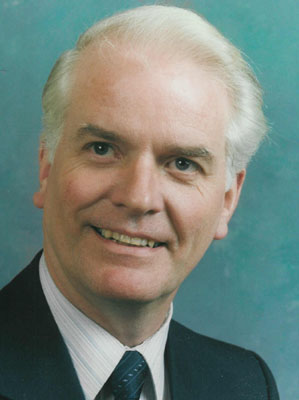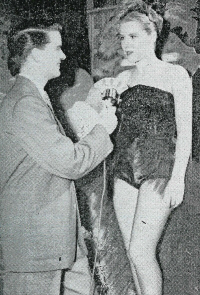

Ron Robinson - CKWX
CKDA/CFMS-FM Victoria 1975-95;
CKXM/CKXM-FM/CKKQ-FM Victoria 1995-2001;
Canadian Association of Broadcasters
Half Century Club 2001
Memories of CKWX
in the 50’s
My first
exposure to radio in the early 50's at CKWX.
It was an amazing place - pre-Ampex and pre-Spotmaster ... but overall the best
designed studios I experienced in 50 years in the biz.
Of course these were the final days of the old-style block programming ... with
still many quarter-hour shows and announcers reading newscasts prepared by a
non-air-type editor.
The studios were at 543 Seymour on the second floor. "A"
control had a raised floor so it could cover to the right Studio A - CKWX
Playhouse. It was a live-performance studio complete with stage and
permanent theatre-type seating; to the left the production studio (B) which
could house multiple stand-up microphones as well as a permanently-miked desk;
and directly in front, an announce booth that was used on-air throughout the
day.
The production control (B) was adjacent to studio B ... and off the stage of
Studio A was Control C. There were Magnecord tape machines in all three control
rooms and three 16-inch transcription-type turntables... most of which were
equipped with Northern Electric (?) 9A arms. These heavy buggers
were capable of scarring any disc (particularly the soft-cut acetates we used
for local commercials) if they were
"back-cued." The commercials had an audible
"beep" put on each cut just ahead of the content ... and if you were
readying some other kind of disk for air you were expected to skip-cue to avoid
the scarring.
The 9A's were essential for playing the vertical-groove World transcriptions
service we subscribed to. There were also more typical Shure or
similar cartridges & arms for playing LP's, and later 45's. The 9A's were
also used on the 78's, which predominated in my early days.
In the early 50's we never considered putting a telephone call on the
air. Our phone-quiz programs would see the announcer repeating the
essential parts of what the listener was saying ... and of course, as a result,
a fair amount of dead air!
The studios were maintained by engineers Charlie Smith and Dave Pomeroy. They
have my undying admiration for creating some of the best sound-proofing I
ever experienced with some excellent wall treatment for optimum sound. We never
wore earphones ....speakers in the control rooms and studios automatically went
to "BG" or background when the mike switch was turned on.
At the outset of my experience the CKWX transmitter (in what is now
My earliest enthusiasm in the business was for the operating side.
We had up-to-two hour blocks of soap operas morning and
afternoon. Juggling the three turntables was a challenge
with each program having a music disk (some musicians union rule wouldn't allow
integrating the network music into the daily drama), the daily episode on TT#2,
and the commercial on TT#3. Getting from Ma Perkins to young Dr. Malone with
often a recorded spot in between, called for some fast disk juggling and
cueing.
And keeping focus on the music cues from the meager and oft-times incorrect
timing scripts, was a continuing challenge.
When I joined the station some of the veterans of the air-staff were Cal
George, Bob Hutton, Reo Thompson, & Vern Groves who was known as
"Bob White" because of the quiz show he hosted. (Even when he read
the news he was Bob White.)
Other
announcers included Jack Kyle, John Sharpe, Eric Gee and Terry
Garner. Laurie (
I really didn't realize how great the Seymour studios were until Elphicke
decided in the late 50's, that it was necessary for radio to make a major
statement in the era of television, and built the "rockhouse on
Burrard." It's significant that I still remember 543 Seymour,
but can't recall the street number on Burrard. That flashy, modern
specially-built-for-radio facility was nowhere near able to meet the high
standard that had been set in the earlier model.
However the Burrard studios were home to the Mountie baseball reconstruction
broadcasts...the $25 fees from which made it possible for me & my family to
get the only home I ever built.
See more
below on reconstructed baseball games…
***
Vancouver
Sun 1989
IF
calling the play-by-play of a long, uneventful baseball game is one of the more
challenging tasks in broadcasting - imagine having to call a long, uneventful
baseball game you're not at.
That was
the situation for Jim Robson and many broadcasters when station budgets lagged
behind the demand for "live" road game play-by-plays for baseball,
and occasionally, football, hockey and lacrosse.
Between
1957 and 1969, Robson, along with CKWX broadcasters Bill Stevenson and Ron
Robinson, began "reconstructing"
Reconstruction
is a polite way of saying they conjured the games out of thin air. Call it
creative broadcasting.
It went
like this:
Say the
Mounties are playing in Salt Lake City. A designated teletype operator sends a
more or less continuous wire message via Western Union on the game details. The
teletype is abbreviated information about the batter, whether he hits right or
left and how he does at the plate (i.e. "S1C" translated as strike
one called).
As Robson
and his broadcast partners received the teletype (a half-inning behind the
action), Robson would effect a supposedly "live" play-by-play.
Robinson - who had taped baseball-game sounds (boos, applause, cheers, the
crack of the bat, a fastball popping into the catcher's mitt) - would mix the
sound effects to suit the action.
"Ron
Robinson was the real genius behind the whole thing," Robson says.
"He was a perfectionist. He would even phone the ballparks and ask if they
played organ music so our broadcast would sound authentic."
"We
even had a P.A. announcer on tape as well," says Robinson, now in news at
Victoria radio station CFMS. "However the crowds were much more reactive
on our recordings than they really were at the ballpark. I felt a little bad
about that."
There
were - ahem - creative problems. Sometimes the line of teletype might be
interrupted and a player's plate appearance sent into a black hole of mystery.
"Once,
when we only had received two outs for an inning, we picked a guy off first
base just to keep the batting order intact," Robson says.
At least
baseball had some kind of order. In 1960 Robson did a phantom reconstruction of
a Western Hockey League game between the Los Angeles Blades and the Vancouver
Canucks. Robson had little more than a game summary to go on.
"It
was a brutal idea," Robson says. "Basically, I had to make the whole
game up out my head."